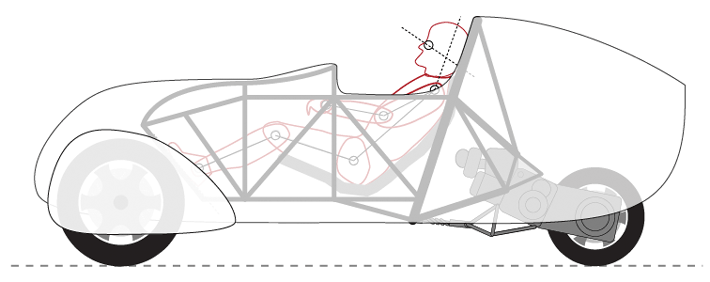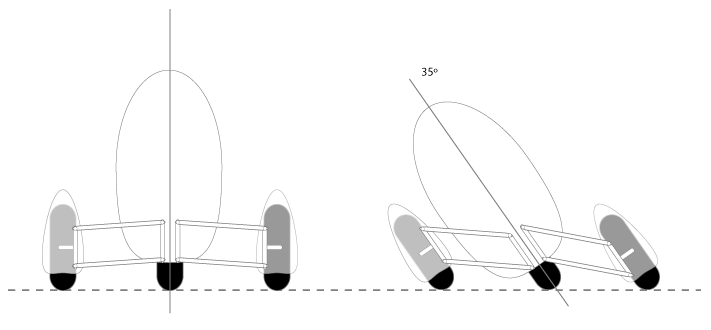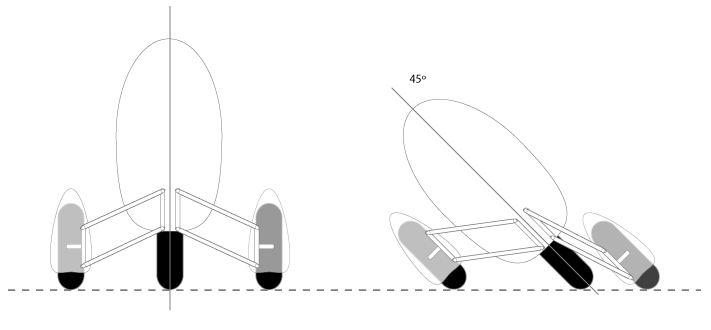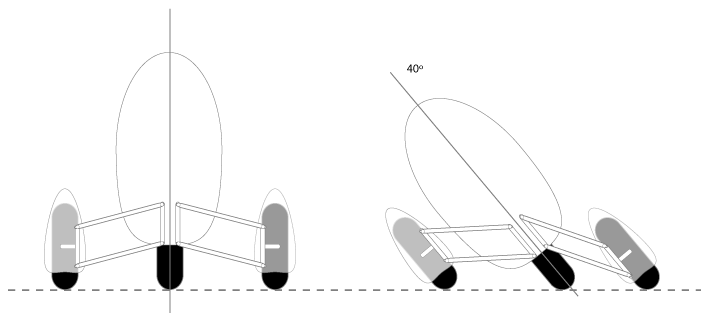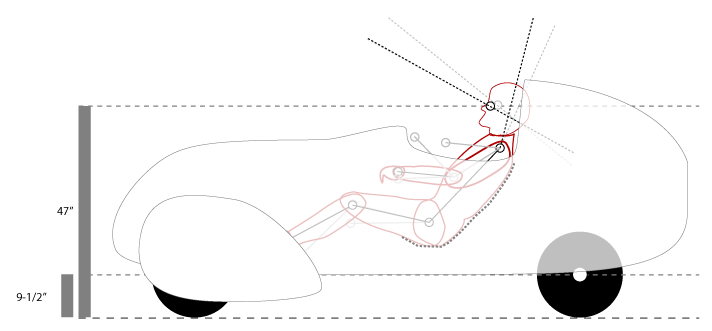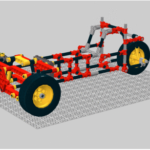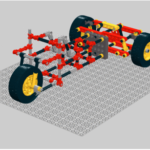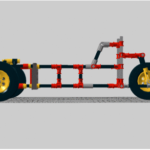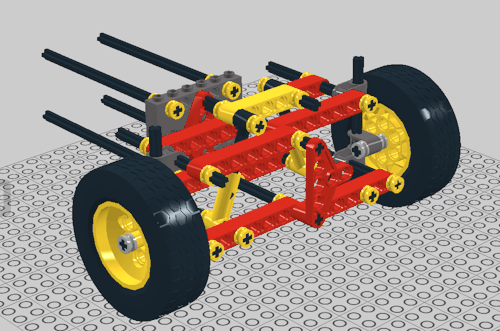
They were apparently absolute murder to ride, but nothing quite says vintage transportation like the Velocipede. The thing I’ve always found fascinating about these is their huge front wheels. The physics of a bike like this must feel very odd compared to bicycles of today. The force of angular momentum of a wheel (the force that makes it want to stay upright and that leans it when you top turn it) is directly proportional to the torque moment of that wheel. Or, said in non physics babble, the bigger and/or heavier a wheel is, the more stable it is when its rolling. It’s kind of an amazing force, when you think about it. The two tiny rollerblade-like wheels of a little razor scooter generate enough angular momentum to hold an adult upright. In larger, powered two-wheelers like scooters and motorcycles, wheel size makes a huge difference in the character of the machine. Scooters have traditionally had much smaller wheels. Most vintage small-frame Vespas had only 8″ rims, while their large frame brothers weren’t much larger at 10″. My modern Vespa has 12″ wheels, but still feels very much like a scooter — agile, and a tad butt-heavy. Motorcycles tend to have anywhere from 14″ to 22″ rims depending on the style. When I test rode a Triumph Bonneville in 2008, what I noticed immediately was that it took about half the speed I was used to in order to get rolling stability. Once moving, the larger wheels and rolling mass of the Bonneville felt so solid — like it was on rails. What would wheel size mean for the Streetliner?
Bigger front wheels
While playing with the proportions and broad strokes design details of the Streetliner this week, I wondered what would happen if I swapped out Burgman-size front wheels for larger wheels from another bike in the Suzuki fleet. The size of the rear wheel is likely fixed because of the shape of the engine/transmission casings. Big wheels up front would definitely give it a stronger visual connection to the old race car designs that have inspired the project. Especially if I grabbed the spoked wheels off of something like the Boulevard S40. But beyond aesthetics, it would make some significant differences to handling comfort, lean feel, and possibly even make the front suspension easier to build. It looks the business though, doesn’t it?
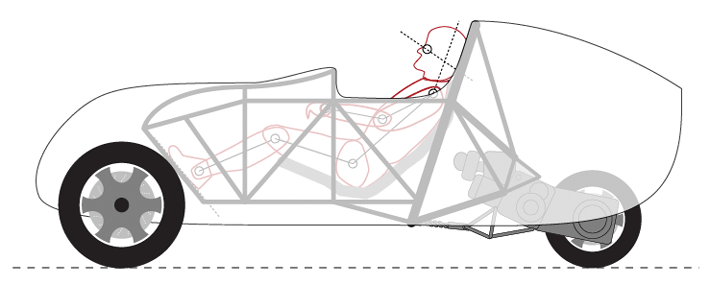
That’s an 18″ rim up front as opposed to the 14″ stock Bergman rim on the rear. It definitely calls back some nostalgic racing mojo. Larger diameter wheels would mean that the front end would take bumps better and have greater rolling stability. It’ll also mean more room inside that wheel for all the tilting mechanicals, brakes, and steering attachments. What it would also mean is that the lower and upper swing arms of the tilting suspension could be further apart — letting me have not only better ground clearance, but deeper leaning on the same distance between the wheels.
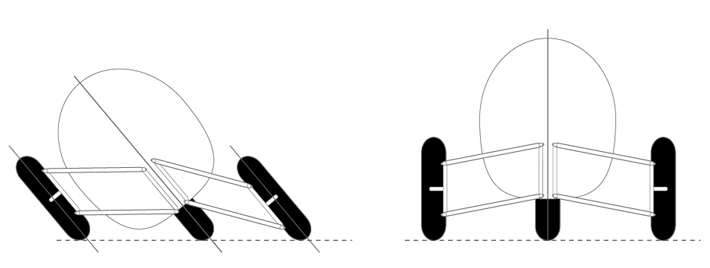
If you go back to my initial lean study, I explored the relationship between body height and leaning. With the larger wheel size up front, a couple of good things happen. First, I’m able to spread the swing arms apart, meaning that at the same lean angle, there’s less interference. This is important at both the wheel attachment points and where the dampening assembly will go (the shocks and their connecting structure, which isn’t shown). The more room there is to work in those assemblies, the better. Not only will it be easier to build, but it’ll mean more opportunity for building fine tuning and adjustment points right into the structure.
Stability
The biggest difference may indeed be felt in leaning stability. The greater mass of those larger wheels would mean nearly instant leaning stability. Whenever I see a Honda Goldwing slowly lean its way through an intersection turn, it amazes me that the 900 lbs or so of the Goldwing are able to be held up at such low speeds. The Goldwing has an 18″ wheel up front and a 16″ wheel in the rear, and that’s enough to keep it stable, even at low speeds. With two 18″ wheels up front, the leaning stability ought to be massive. But more than that, having the swing arms further apart vertically, means that the side-to-side forces generated by the wheels when they precess (based on steering input) will not only be greater, but have more leverage on the body of the vehicle.
The one thing I wonder about, however, is what it will do to the driving feel of the vehicle? Greater stability means that it will take more input force on the steering to induce the lean — and that force will grow with speed. That’s a good thing, as you wouldn’t want the vehicle to be all twitchy at 70 mph. I’m not worried about it, I just wonder what the feel will be. I imagine it wouldn’t be much different than a big cruiser motorcycle with the Tilting Motor Works kit installed.
Wheel pants
From the beginning, I’ve envisioned the Streetliner with wheel pants for added aerodynamics and efficiency. This inspired by both ’30s era aircraft like the Gee Bee but also similar projects like the Aptera. Exposed wheels simply aren’t very aerodynamic. Putting a streamlined shroud around the wheels will add effeciency (and look fantastic). However, I’m not exactly sure just how much efficiency is gained. Adding wheel pants will definitely add time and complexity to the build, and at some point I’m going to have to do an aerodynamics study to see how much more efficient the shrouded wheel is than a naked wheel. One thing I have to keep in mind though, is that unless I can put a decent tail on the pants, there won’t be much advantage in the wind. However, that tail will quickly limit how far I can turn the wheels (because the tail of the pants will hit the body). That means a large turning radius, and for a vehicle intended for mostly city use, that’s not a good thing. So if I have to sacrifice wheel pants for the sake of turning ability, that’s a compromise I can’t not make. But I do just love the look of the pants. I hope I get to keep them.
